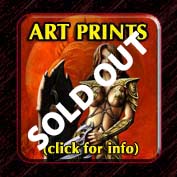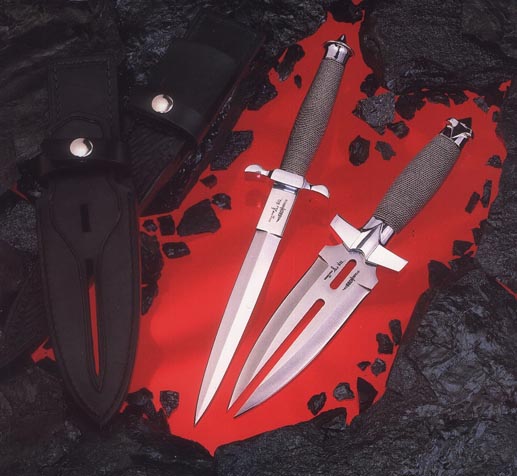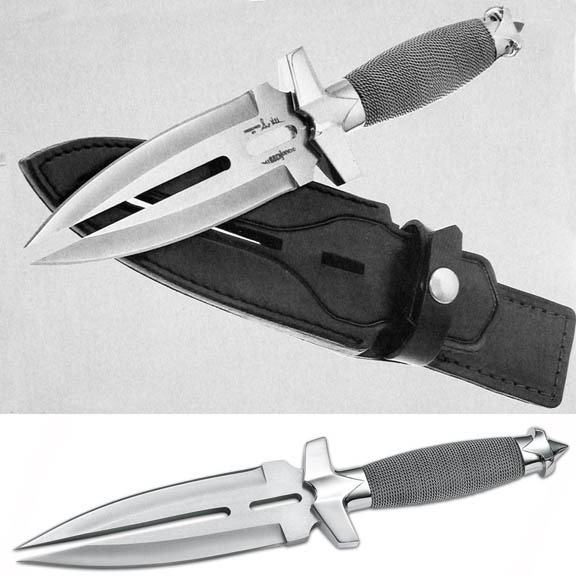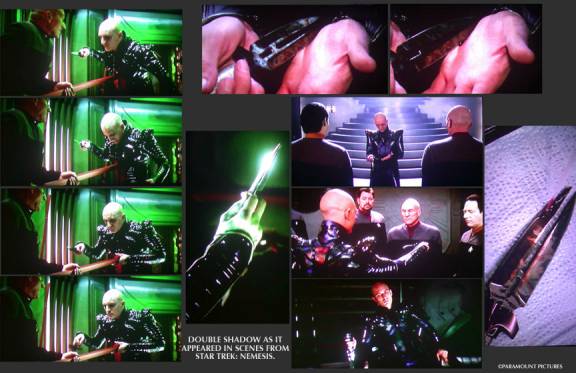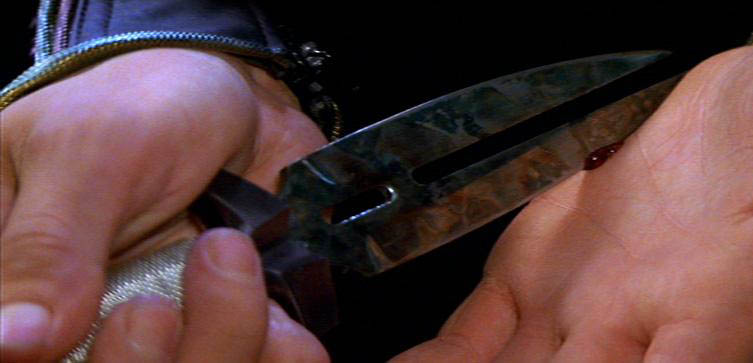
OTHER KNIFE DESIGNS BY KIT RAE
Outside of the Kit Rae Fantasy Art brand, Kit has designed numerous knives, weapons, and tools for various companies, mostly in the tactical and sporting catgories, and he supervised the replicas for many licensed film and video game weapons. After constant inquiries about these items we started sort of a scrapbook list. The Brands Kit has designed for include Honshu, M48 Kommando, United Cutlery, Combat Commander, Black Ronin, Tailwind, Rigid Knives, Colt, Harley-Davidson, Stanley, Remington, Gil Hibben, among others, going way back early in his career. It is by no means complete, but most of his designs are listed, to the best of our memories. The list goes back to approximately 1985 when Kit first started in the knife business. Click on a Brand to go to that section.
BACK TO OTHER KNIVES MENU PAGE
GIL HIBBEN CUSTOM DESIGN SERIES
Many people have questioned who actually designed the United Cutlery Gil Hibben line and who designed my knives and swords due to the similarities, so here is the straight story. I also get numerous emails asking how to get in this business, how the design-to-product process for mass produced knives works, and what skills are needed, so I thought this would be a good opportunity to show some my design evolutions and control drawings to give a rough idea for beginners. There were many phases in the design process of a fantasy knife back then.
For some background on Gil, check out his website, www.hibbenknives.com, and also check out Mike Carter's Cartertown website with lots of info on Gil and his creations. The short of it is that Gil is a legendary custom knife maker who has been in the business since 1964, and is recognized as one of the finest and most accomplished knife makers in the world. At the time United Cutlery started to work with Gil, he was making some of the most fantasic bladed works of art in the custom field, almost sculptures in steel. He and Sylvester Stallone teamed up to design a knife for Rambo IIII in 1988, which spawned a relationship between Gil and United Cutlery owner Kevin Pipes to market a licensed replica. I worked there at the time for Kevin, helping developing Gil's line, creating designs, and eventually supervising it until around 2005. Being a huge fan of Gil's work, it was a very exciting time. The Hibben/United collaboration was one of the first relationships between a factory and a custom knife maker, and probably the most successful. It opened the door for custom knifemakers to get their creations to more people.
I must first say that before you read this understand that there are many people involved in the various aspects of designing a knife, not just the person who’s name goes on it. Some people may be shocked to find that some knives from the Hibben Knives Custom Design Series were not actually designed by Gil. Many were, but many were not. This was not an attempt to deceive anyone, it is just that it takes many people to create a successful knife line. Of course the bottom line in any business venture is sales, but we always attempted to keep the spirit and integrity of the line intact. For the fantasy series, our goal was to make a great knife line that would make collectors happy, and give them a factory made knife that was near to the look of a custom hand made knife, but in an affordable price range for the average person. I recieved no extra compensation or royalties for my work, and I never asked for it. I was simply a salaried employee of United at the time, and agreed to do this for my love of the work. And for the record, if there had never been a Gil Hibben (or Paul Ehlers) my designs would look totally different. I was heavily influenced by many custom knife makers, and Gil's creations were some of my favorites.
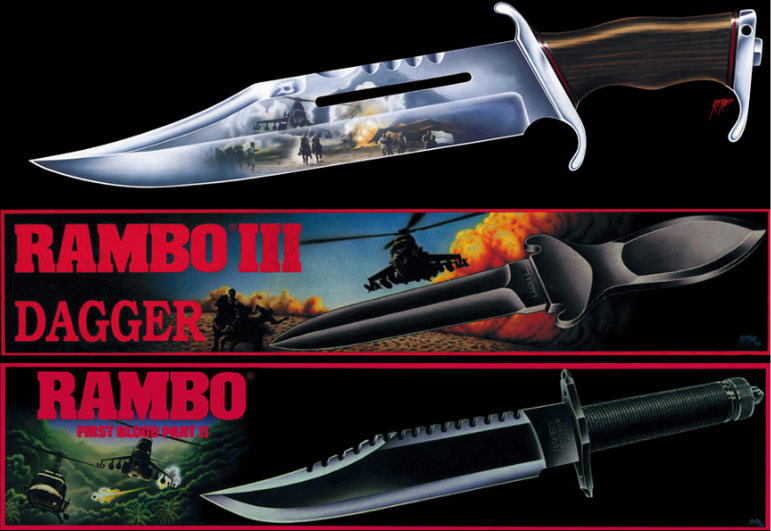
Rambo III Bowie and dagger box art (1988) - One of the first projects I worked on for a Gil Hibben product was to paint the box art for the Rambo III movie bowie and dagger replicas. United Cutlery had just gotten the license to replicate the knives Gil created for the film (and later licensed the Rambo: First Blood and Rambo II knives). I did very little work on the actual replicas - some basic drafting pattern drawings (I was still learning proper drafting), but otherwise, the factory did most of the work replicating Gil's knives. I was a fine artist on the side, and had recently been doing airbushed advertisements for knife ads used in the retail catalog of one of United's partner companies, so I was asked to airbrush the packaging art. In one of the Rambo III movie trailers they show Gil's knife slowly panning across the screen as scenes from the film play on the blade. We loved that, so I replicated it for the box top. For the other knives, I painted scenes from the film behind the knives using snapshots from the film as reference. To say the Rambo III bowie was successful is an understatement. It was the most successful prodcut United had ever produced. Suffice it to say, United and Gil teamed up for a line of Hibben production knives soon after.
UC453 Double Shadow (1991) – After the success of the Hibben Rambo knife replicas, United signed Gil up for an exclusive license to design knives. The Hibben Custom Design Series, a line of production knives to bear the Hibben name. It was to be an annual knife, and the first knife produced was the Silver Shadow in 1990 (a name I came up with for an all stainless Rigid folding knife I designed, but it fit perfectly with this knife). I was not involved with the initial idea for that knife, I just helped with the control drawings for the factory to replicate it. The Silver Shadow sold very well and UC needed a follow-up knife for 1991. The Shadow was basically a customized V-42 stiletto so it was not that hard for United make a production version, but we wanted something more elaborate and custom-looking for the follow up. Gil was known at the time for his wild fantasy knife creations. He created a few new designs, really nice survival type knives as I recall, but none of us really thought that was the right direction. Early on, the line seemed to be more of a commitee driven thing, with input from Gil, Kevin Pipes and the other three United partners, and myself. We looked through photos of Gil’s custom knives, many designed by the wonderful Paul Ehlers and skillfully turned into 3-D art by Gil. Those were more in the direction of what I would have liked to have seen made, and what I pushed for, but they were way beyond what we could do on a production basis at the time.

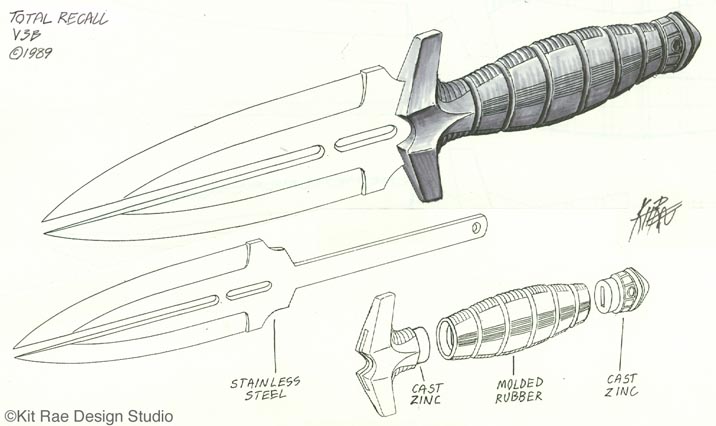
Shown above - My original Totall Recall design and projection view drawings with notes. These show the basic information needed for a knife design to be manufactured. Essentially it is a set of patterns visualizing the knife from every angle needed, and basic material and finish specifications. From there, either myself, or the factory would draw up a set of drafting drawings with all pertinent dimensions, exact material notes, and finish specifications. The tool makers would use those drawings as a guide to make the blade die stamp tooling, steel casting molds, and injection molds, in order to mass produce all the raw component parts and assemble a final knife.
I had been working on knife designs for the Paul Verhoeven film Total Recall the year before, which United was in the process of getting a license for, but due to the shooting schedule we were too late to get anything in the film. One of the designs I came up with was a split blade knife with a futuristic tactical handle (a blade I stole from one of my earlier, unmade fantasy knife designs, the Dragon Claw). We all liked the knife and one of UC’s owners, Kevin Pipes I believe, suggested we use it as the next Hibben knife. I was not real thrilled with that idea, but the knife would be expensive and probably would not get made at all if we did not have a well known brand on it. I was torn because I wanted to be credited with my own design, but who would not want Gil Hibben to make a custom version of their design? As I recall, I was told I could also get my Dragon Claw version manufactured later, so I agreed. Gil created knives based on other people's designs all of the time, so it was nothing unusual for him. He still had to turn a flat, 2D drawing into a 3D work of art, which was no easy task. I revised my Total Recall drawings, keeping my original blade design, but redesigned the handle and removed all the techy details. I changed the grip to wire wrapped so as to match with Gil's Silver Shadow knife and added a matching pommel. I was not sure how Gil would like the idea of me designing a knife for his line, but I showed it to him at the Blade Show that year (which was held in Knoxville, Tennessee in those days). He liked it and said he would make a custom version.
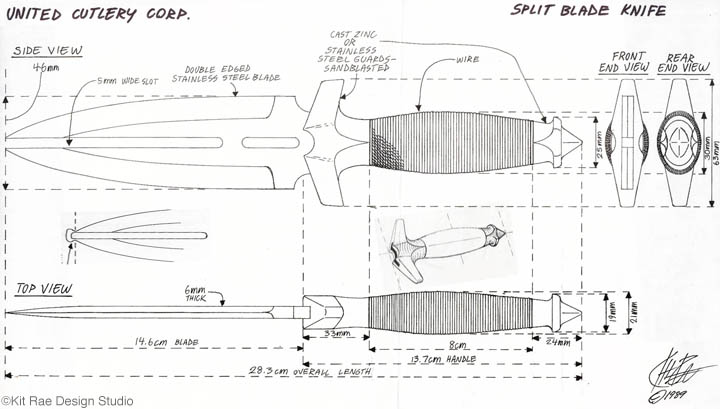
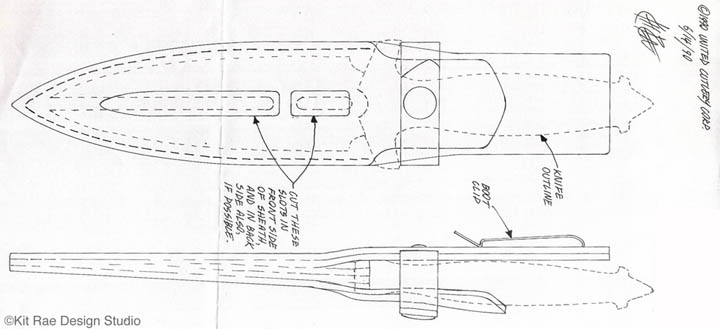
Shown above - My revised Double Shadow knife and sheath projection view drawings and sketches with notes, after I "Hibbenized" the design to be stylistically similar to the Double Shadow.
Note the sketch on my control drawing showing the blade tips connected. This was something Gil suggested, as he had a lot of experience creating wild blades with miltiple points. The split blade tips would warp and point differently when heat treated, so connecting the blade tips before heat treating, then grinding that steel away after, avoided this problem. The whole polished steel look with the wire wrapped grip of the Double Shadow was something I had seen on a few swords and knives made by Tom Maringer at a custom knife show in 1989 or 1990. I loved Tom's work and remember talking to him about how he made the wire (two strands of stanless steel twisted together), how he anchored the ends to the grip, and how he formed the Kydex sheaths for his Vorpal knives (Tom and fellow shop mate Doug McGowan were the first to thermoform knife sheaths made of Kydex). Sadly, Tom stopped making custom blades in the mid 1990's, but his Kydex sheath idea is used by hundred's of makers today.
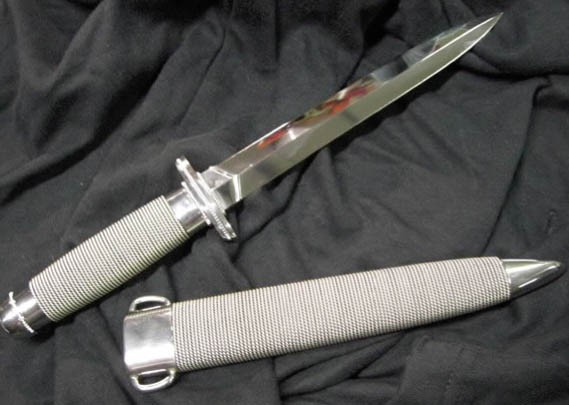
Shown above - A custom dagger hand made by Tom Maringer with Tom's signature look that influnced the look of the early UC Hibben knives - wire wrapped grip and polished steel hilts.
Gil was doing highly polished blades and hilt parts too, but his grips were usually solid materials - woods, Micartas, imitation amber, et cetera. The wire grip made the whole knife look different. The look was more Harley-Davidson than medieval, but I loved that ulta-clean style. I don't remember if it was me who suggested that look to Gil for the 1990 Silver Shadow knife, or one of the United partners, Kevin Pipes or David Hall, but I though it worked and used it for the Double Shadow as well.

Shown above - My rendering of the final Double Shadow design for manufacturer reference, later used on the packaging. I did not really need to create anything with this much detail, but it did help in visualizing what the final product would look like, so I painted a photo-real piece of art for most of these knives. We were able to use every one of those paintings on the packaging, which was all artwork-based back then. It also gave me an excuse to paint and airbrush.
Shown above - Gil Hibben's original custom version of the Double Shadow.
Several weeks later Gil’s custom knife arrived at the United office. It was an incredible feeling to see my knife design turned into a real handmade knife by one of my favorite knife makers. Gil's version was much thicker and he made the guard and pommel out of solid brass rather than polished steel. I don't think he was into wire wrapped grips so much, so he used Micarta instead (dark red, as I recall), and his hilt shape was very different from my design. We decided to keep the production version just as I had designed, including the polished metal and wire wrapped look of the Silver Shadow, to keep continuity in the line. I was just told that Gil was OK with whatever we wanted to do, but I'm not sure if he was really OK that we did not use his hilt design. After looking back on Gil's version a few years later, I really liked his grip and pommel shape better that what I designed.
Since this was the follow up to the Silver Shadow, United owner/parter David Hall suggested we call it the Double Shadow, since it had a split blade. It went on to become one of the most successful knives in the line. I also designed a wire wrapped, all black version, which was made a year or so later, and after that we made a gold plated limited edition. I think this was the first time I started using the phrase “fantasy knife” to describe this type of product and in our marketing materials. Several people have told me that I was the one who came up with that term, but I actually think it was in used in print long before that to describe knifemaker Bill Cronk's custom knife creations. The Double Shadow has appeared in more movies and television shows than any other UC knife. Here’s a short list of its appearances: Babylon 5, Crusade, Space Rangers, White Dwarf, Gladiator (not the Ridley Scott one), Hideaway, Timecop, and The Fifth Element. It also made an appearance in Star Trek: Nemesis thanks to Gil sending his contact at Paramount a few samples.
Update: The Double Shadow was reissued by United Cutlery in 2011.
Update: In 2012 Gil made a new version of the Double Shadow for the Sylvester Stallone film Expendables II.
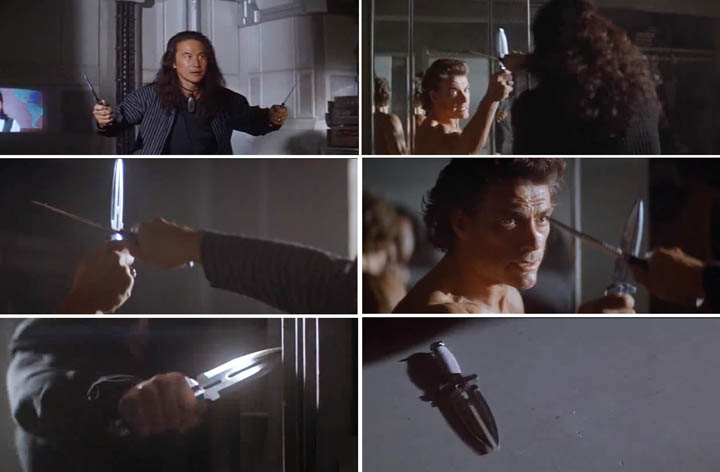
Shown above - Two Double Shadows used in the Jean-Claude Van Damme action film, Timecop (1994)
Shown above - The modified Double Shadow from Star Trek Nemesis (2002)

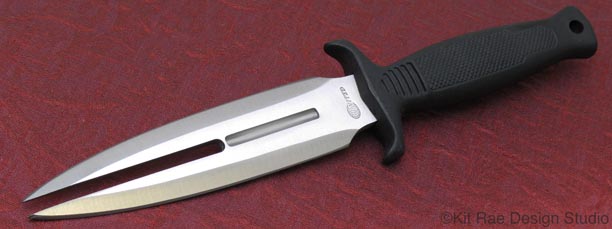
Shown above - A few of my other split blade designs, the medieval styled Dragon Claw for United Cutlery (UC699), and the Wasp Boot Knife (UC728) released after the Double Shadow.
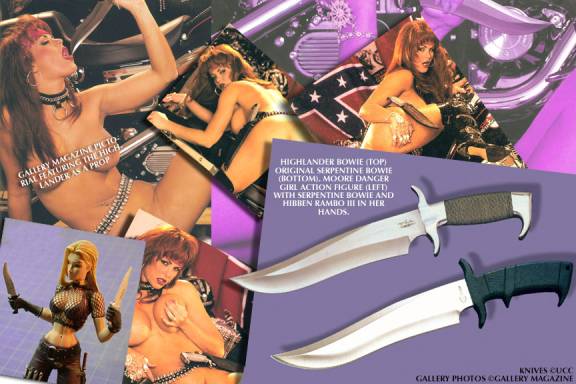
UC627 Highlander Bowie (1992) – When it came time for the third knife for Gil’s series we again stole another of my UC knife designs, this time a camp bowie I was working on. The design was reworked and customized with the polished metal and wire look already established. We also made my original design as a UC knife, the UC469 Serpentine Bowie, so I did eventually get my name on the design. I don't think Gil ever made a custom version of this one. Sales were OK, but nothing likte the Double Shadow. The Highlander was used in the X-Files episode The Calusari with a modified handle. It has appeared as a toy accessory and even was used in a nude Gallery magazine pictorial (thanks to Jimmy H. for the copy of the issue). In the Oliver Stone film Natural Born Killers, Woody Harrelson throws the Highlander and the camera tracks it spinning through the air as it sticks into a person's back side. I like seeing my knives in films, but that is not one of my favorite scenes.
UPDATE: The Highlander bowie was reissued in 2010.
UPDATE: The Serpentine bowie was revamped and reissued in 2010.
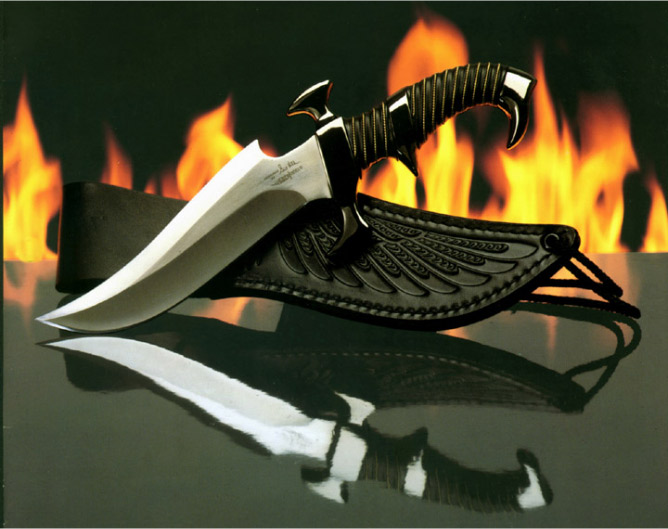
UC700 Raven (1993) – Since I was becoming UC’s primary knife designer I kind of willingly took on the role of coming up with design of the Hibben annual knife each year at this point, as well as supervising and art directing the marketing images and advertising layout. For the 4th annula knife I was determined to make something that had the “look” of a Hibben custom fantasy knife instead of converting something I had already done. I wanted something with that flowing, elegant curvy look that people would identify with Hibben. I looked at many of his incredible fantasy knives trying to find one that could be simplified into a production knife. One of my favorites was a knife called the Elf Dirk.
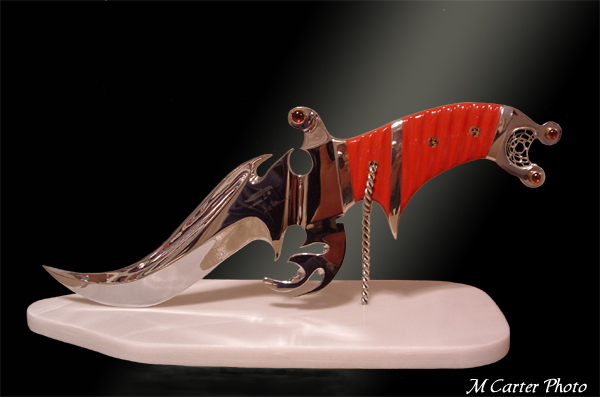
Shown above - This is not the exact knife I based the Raven design on, but it is a similar pattern to the original Hibben Elf Dirk I saw.
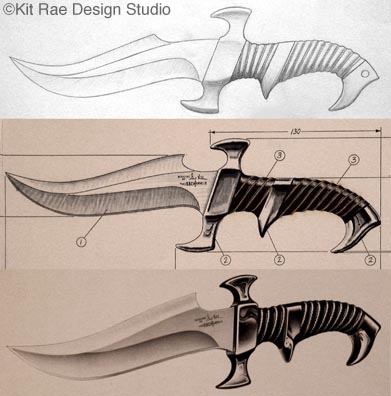

Shown above - My Raven design drawings and original control drawing.
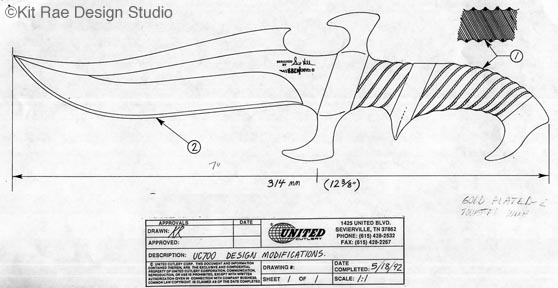
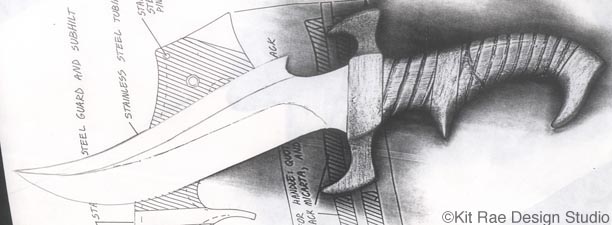
Shown above - Raven final design with enlarged blade, and a wood model with paper blade to check the hand fit.
That was the basic shape I played off of, even though the final knife is very different. I created several designs and sent the best one to Gil. He suggested some changes to the hand guard and then I got rolling on the final control drawings. This was really the very first time the design was based something Gil had actually made. We went for a black chrome look this time, and a fluted handle grip like the original Hibben knife, which I think had a sheep horn handle. I wanted the black look because of some of the custom knives I had seen made by Buster Warenski (a student of Gil's) and Fred Carter were all black plated. Gil had not done much in black that I recall, but we thought this would work for Gil’s line and the collectors responded very well to it. The finished knife was very successful. I don't think Gil ever made a custom version of it that I recall, but he did make some custom version with completely hand made blades. It appeared in an episode of Chris Carter’s excellent television series Millennium.
UPDATE: The Raven was reissued in 2010.
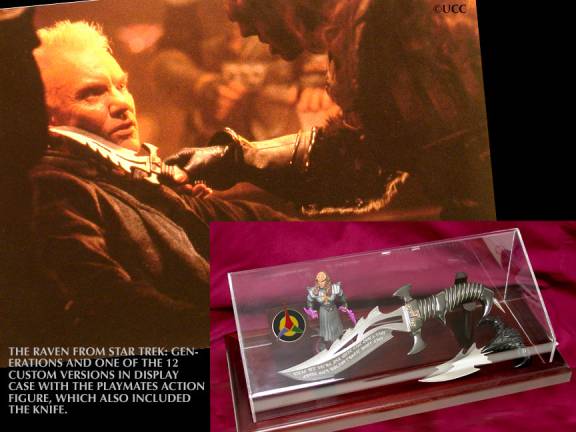
Klingon Version of the Raven – Gil and I worked on this modified version of the Raven for Star Trek: Generations in 1994. It is the one held to Soran’s (Malcom McDowell) throat by B’Etor, one of the Klingon Duras sisters. The producers picked it because it had a Klingon look. I redesigned the blade based on one of the production designer’s sketches and added the Klingon lettering. Gil built the new blades, which were placed in stock Raven handles for the film props, and added the pommel spike. A friend of Gil’s cast the Klingon symbols mounted to the hand guard. The knives seen in the film were dirtied up to make them look used. As a huge Star Trek fan this was a blast to work on, as know it was for Gil. He later made 12 custom versions of this, including one for me. The toy action figure of B’Etor also came with the knife as an accessory.
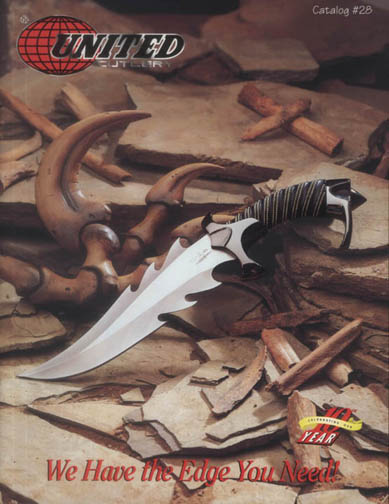
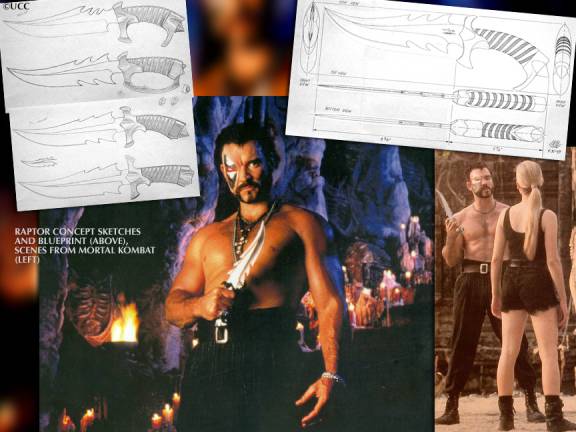
UC750 Raptor (1994) – My second attempt at making a knife that had that Hibben fantasy knife look. I think I got a little closer this time, although I had Klingon knives in mind more than anything. The initial idea popped into my head as I was about to go to sleep after a late night or working, so I quickly sketched the ideas out on a scrap of paper before they disappeared. I was into Star Trek: The Next Generation, specifically the developing Worf story line, so my brain was probably thinking of what I would have liked to see used in the show. It was very bizarre when the knife was actually later used in Star trek Deep Space Nine! It was suggested the knife be called the Raptor by one of United's owners, so that became the marketing theme. I designed a 3-D dinosaur scale embossed surface design for the sheath face, and I was so into this one that I carved a fossilized raptor claw prop to use for a photo shoot for our catalog cover and advertisements (photo by John Stewart). This knife was used in the film Mortal Kombat, featured on the cover of Blade magazine, as well as several other top retail catalogs.
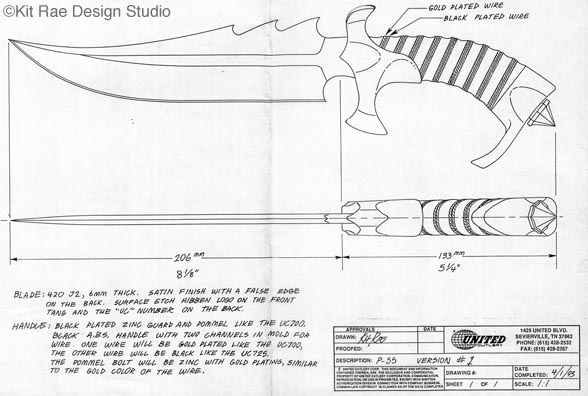
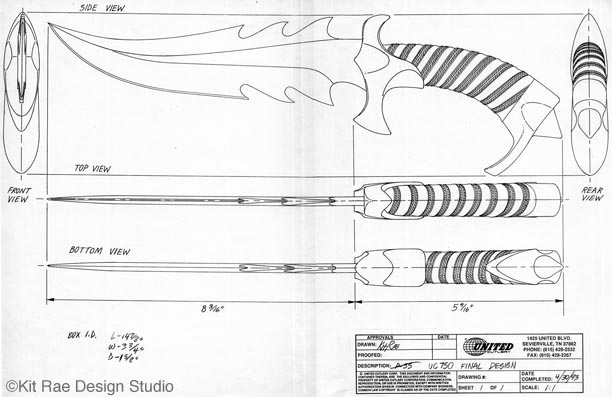
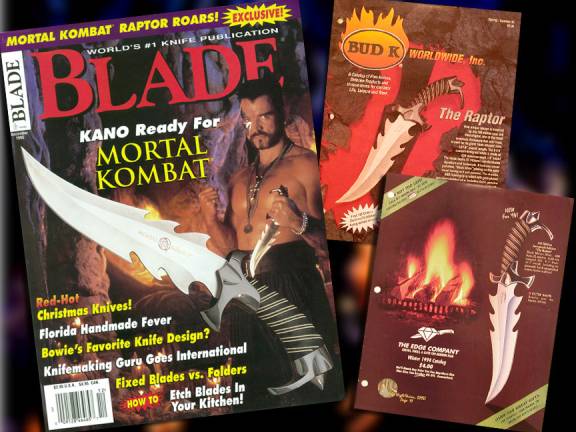
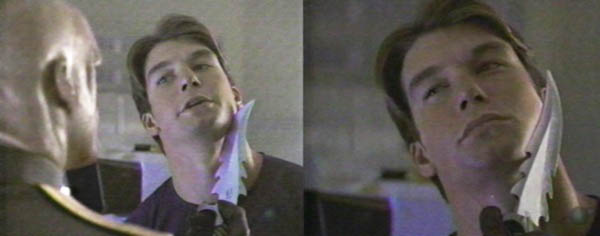
Klingon Version of the Raptor – The stock knife was used in Star trek: Deep Space Nine by Dax to threaten Captain Sisko in a mirror universe episode. It had a very good close-up. I think the episode was called Through the Looking Glass. It was also seen on the weapon wall in Worf’s quarters in a few episodes. After this I began to see Klingons in full dress wearing the knife at scifi and comic book conventions! This knife, along with most of the previous Hibben knives I designed, was on display at the Star Trek Experience in Las Vegas. Gil’s versions of two of the show’s primary swords were displayed there as well. He was named the Official Klingon Armorer by Paramount, although prop maker Dragon Dronet was actually the man responsible for many of the original weapon props made for the television shows. The knife also appeared in the television show Sliders.
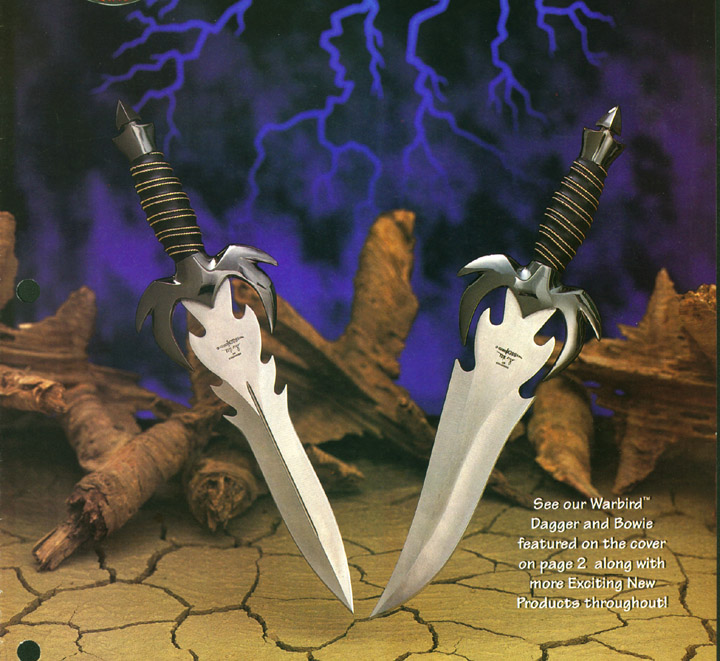
UC849, UC850 Warbird (1995) – I admit I failed miserably on this one. I based the design on a real Hibben custom knife, something Gil designed for the Harley-Davidson Owners Group as I recall. The project was rushed and I did not spend enough time on the wood model for the handle parts. The finished knife came out too fat and stubby looking. I was not happy with it at all, and I don’t think Gil was either. Double-edged knives were becoming a problem to ship into Europe so I was asked to make a single edge bladed version, which looked even worse. I was into photography and prop making at the time, so I art directed and set up the catalog cover photo with photographer John Stewart. This was in our pre-Photoshop days so John had to capture everything in camera, which was a challenge creating lightening and smoke effects, while keeping floating knives (hot glued to thin wood rods) from falling down!

